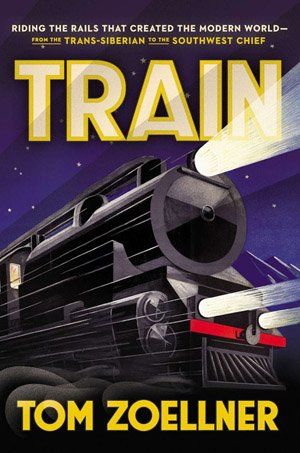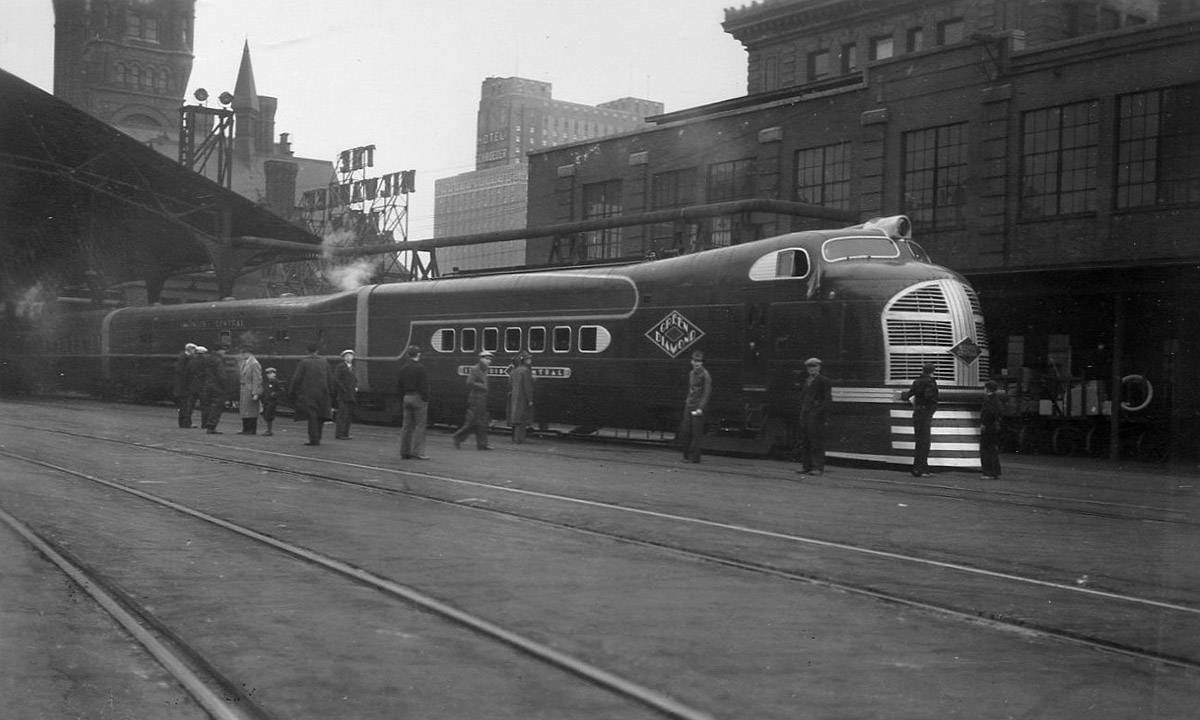In this excerpt from Tom Zoellner’s excellent book, Train, the author recalls the historical rail route of the ‘Great Migration’ of the 20th century, when black Americans traveled from the deep south by the millions, seeking opportunity in the big industrial cities of the north, Chicago most notably.
The Cardinal flew through old cattle corridors and the dingy suburbs of Calumet City and Riverdale, past stacked intermodal containers and shattered factory shells and scarred oaks and then into the diametrical rows of painted three-story tenements that form the core of traditional Chicago home life: portable barbecue grills on the fire escapes of sturdy and no-nonsense wood siding painted dark brown. Protruding from a square hole in a redbrick façade was a small conveyor belt, and it carried metal ingots, a tiny and miraculous demonstration that heavy goods were still being made in the USA.
We passed west of Comiskey Park, where the White Sox used to play, and aimed for the heart of the Loop, and in minutes we were creaking forward inside a dark cavern of pillars before easing to a stop. Through a set of concrete beams to the immediate east was the greenish chemical water of the Chicago River. There was a bored mutter from the conductor over the PA reminding us to gather our bags—an anticlimactic whimper after our night journey across the mountains. We queued up like cattle at the Superliner staircases and shuffled out onto the platform.



Chicago Union Station is an awkward truce between civic romance and suburban pragmatism. A drafty 1925 headhouse was grafted onto a two-story shopping mall with a Soviet-style ticket hall in the basement. Fifty thousand office commuters crush in twice every weekday. Most of them are not using long-distance Amtrak but Metra, the public authority that runs eleven lines snaking out to the western suburbs and the Wisconsin shore, the second-largest regional transportation authority in the nation, behind only New York City’s subway system. Metra loses a dependable $300 million every year, and though only 2 percent of working Chicagoans use it, it is considered politically untouchable.[1] A baggage carousel sits near the gates of the departing Amtrak trains, and an eerie computerized voice sounds through the departure halls, recordings for the hearing-impaired that ricochet off the floors as a traveler walks past, Track 21 . . . Track 21 . . . Track 21 . . .
I went outside and visited the site where an older Chicago railway station had once stood. The corner of Twelfth and Michigan is now a grassy field, and a working Metra track off to the east is the only remaining evidence of the big trunk line into the Deep South that once terminated here at what was the Illinois Central Depot, the signature station of the railroad that had plunged into the former slave states and the rich cotton country. The Illinois Central called itself the “Main Line of Mid-America,” and it carried lumber, bananas, limestone, cheese, peanuts, bees and strawberries up from the South. When it carried $15.5 million of gold bullion for Fort Knox, it made sure the newspapers heard about it. But there was no official press release about the most important thing the Illinois Central would ever carry, for its web of southern connections meant that it would play, if only by accident, a critical role in one of the epochal human movements of American history.
The “Great Migration” was a catchall name for the exodus of blacks between 1916 and 1970 from sharecropper cotton and Jim Crow laws and lynchings. More than 6 million African-Americans streamed northward on the railroads to begin a new life.
Railroads hadn’t always been a happy symbol for southern blacks: they had occasionally been the means of ripping families apart when slavery was legal. “We heard wailing and shrieks from the cars,” reported Jacob Stroyer, who watched in South Carolina as a train prepared to take newly purchased slaves to Louisiana. But the more hopeful image of the Underground Railroad of the antebellum era was the better comparison for the migrants. Here was an actual railroad that could take captives out of bondage, if they were lucky and courageous enough.
The first obstacle was scraping together enough money to pay the fare, which ranged anywhere from fifteen to twenty dollars. For a family whose annual income might hover around two hundred dollars, this was a huge amount. White station clerks were known to refuse sales of long-distance tickets to blacks, and one common trick was to buy a ticket on a short journey in hopes of finding a more sympathetic or indifferent face behind the window at the next station. A canny traveler could also walk down the tracks away from the station and jump on board as a hobo until Memphis, where, as the Commercial Appeal reported in 1922, “two hundred Negros on an average . . . leave on every evening Illinois Central northbound train.”
Women would dress themselves as men and hope not be recognized. Stories circulated of families tossing away their furniture and clothing at the railroad depot when they found they could not check it as baggage. Heirlooms were sold for pennies on the dollar. “You could see hundreds of houses where mattresses, beds, wash bowls and pans were thrown around the back yard after people got through picking out what they wanted to take along,” said an observer in Decatur, Alabama. One escapee told his boss he was going to see a circus. Some who walked into town to see off a relative or an acquaintance made the decision themselves to leave on the spot, deserting fields full of the owner’s crops that wouldn’t be harvested. The New Orleans jazz crooner Louis Armstrong watched as his family friends “crammed everything into their baskets but the kitchen stove.” Yet the frenzy to leave was pulsing with hope. A rail passenger car heading north from the Delta was seen with the name of a popular song chalked on the side: farewell, we’re good and gone. A young Langston Hughes, who grew up in a series of midwestern towns, recalled going down to the depot to stare at the tracks that led to Chicago, “and Chicago was the biggest town in the world for me.”
The journey was often a migrant’s very first experience of riding a train and of moving any faster than walking speed, which was unnerving, as was the mingling of whites and blacks in the railcars once the train crossed into Illinois.[2] Families could eat in the dining car among the whites if they could afford it, and some ventured the splurge. Some of the gutsier young men made a point of finding an empty seat next to a white man once the train had crossed the Ohio River—the traditional line of demarcation that the Defender routinely called “the Styx.”
Charles Denby from Lowndes County, Alabama, recalled years later being “very uncomfortable for the first hour” of sitting next to a white fellow traveler, who at first maintained a cryptic silence. Then came a small courtesy that changed everything. “He was reading a paper,” wrote Denby, “and when he finished half, he pushed it to me and asked if I wanted to read. He wanted to know where I was going, and said ‘Detroit is a nice place.’ This was the most relaxing time I had.”
Other travelers sang hymns or prayed or stopped their pocketwatches as the sooty crown of Chicago drew closer. The blast furnaces and relentless phalanxes of brick cold-storage warehouses, the acrid stench of the stockyards, the chillier air, the grimy streets, the steel-framed skyscrapers floating on the horizon, the crowds of Poles and Irish workmen in overalls, the women in frocks at the suburban stations and the mind-bending and dazzling scale of the lusty metropolis seemed both wonderful and awful. “To those arriving at night,” wrote historian James Grossman, “the sight must have been particularly impressive and disorienting, as the fiery smokestacks never rested, denying the natural rhythms of night and day that ruled agricultural labor.”
They disembarked at the Illinois Central Depot, a proud nine-story edifice with a bell tower and an electric “drink Coca-Cola” sign and what was then the largest train shed in the world, a soaring arc of coal-smoked glass and riveted steel. The waters of Lake Michigan stretched out to the vanishing point from the eastern edge of the rail yard, and out the entrance the city roared. “I never seen a city that big,” recalled Louis Armstrong, who arrived in 1922. “All those tall buildings. I thought they were universities. I said, no, this is the wrong city. I was fixing to take the next train back home.” They were to find Chicago a difficult home in its own way and hardly a paradise—street crime, corrupt politics, segregated neighborhoods, a marginalized power base—but the black experience in America would be profoundly shaped by this railroad hegira.
On a train through Mississippi one night, I met a veteran of the late migration. He was a sad-eyed man named Larry Wilkerson who had been working on a cotton farm near Evergreen, Louisiana, in 1963. On September 19 of that year—he still remembers the date—his sister phoned him from Chicago and told him she knew of a job that paid exponentially more than he was making in the fields. “I dropped that hoe,” said Wilkerson, “and caught the train north.”
He worked in a restaurant before finding better work with Chicago Public Schools as a substitute teacher and then with Amtrak as a conductor. He was going home to Louisiana to see family but hadn’t been feeling right since the day a car had hit him as he was crossing State Street. It put him in a coma for a month, and he’d been unable to speak or move, though he was awake and knew what was happening. They performed several operations on him—“butchered me like a hog”—before he found his voice and recovered, though he walks and speaks slowly.
“Sometimes,” he said quietly in the club car, “you feel like you’re just going around in circles. If you’re just looking around all the places you’ve been, you think to yourself, Was I good enough? Did I touch enough people? But for now I’m happy to be here. Do what I can do. Say what I can say.”
Buy Train: Riding the Rails that Created the Modern World
[hr style=”solid|dash|dots”]
[1]When a longtime director named Phil Pagano found himself under investigation for financial irregularities in May 2010, he killed himself by walking in front of a speeding Metra train. In his pocket was an operations manual explaining the procedure for how to handle a suicide on the tracks.
[2]The 1896 Supreme Court decision Plessy v. Ferguson, which enshrined the doctrine of “separate but equal” on southern railroads and in other places of public access, had been triggered by railroad seating arrangements: Homer Plessy, a New Orleans man considered an “octoroon” because he was one-eighth black, made a point in 1892 of trying to ride in a whites-only car of the East Louisiana Railroad. It was a publicity stunt and deliberate lawsuit bait that anticipated Rosa Parks by more than a half a century, but it backfired. The verdict only helped strengthen the practice of setting aside supposedly equal “colored” cars, which were invariably shabby and often placed directly behind the coal tender, meaning that the occupants breathed the worst of the smoke and the cinders.




